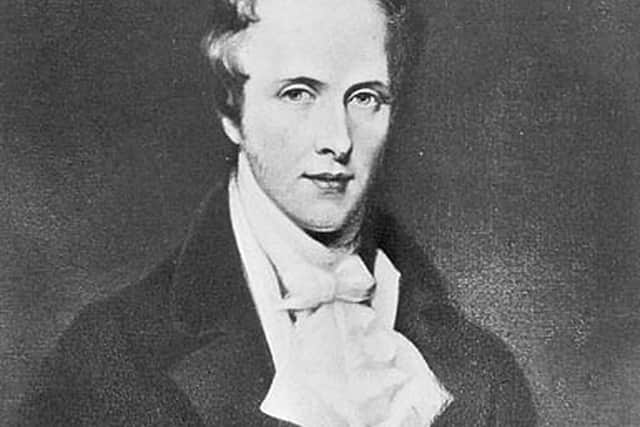Scotland asked to recognise and ‘heal’ its role in colonisation of indigenous lands


A key figure of Canada’s Métis nation has called on Scotland to recognise its role in the colonisation of indigenous lands and to raise greater awareness of the shared culture and ‘often troubled’ history between the two countries.
Dr Adam McInnes, of the Scottish – Métis Cultural Alliance, said it was time for greater acknowledgement of the impact of Scottish emigration on the Métis whose territories in present-day Manitoba were first settled by Highlanders forced from their homes by the Clearances in 1812.
Advertisement
Hide AdAdvertisement
Hide AdLand for the colony, known as Red River, was bought from the Hudson’s Bay Company, which had a Royal Charter to monopolise fur trading in the area, with the Scots arrivals impacting the identity of the Métis nation through intermarriage and cultural exchange while prompting period of conflict as commercial tensions intensified among fur traders.


Dr McInnes, whose ancestry has been traced back to Orkney, where HBC recruited many of its employees, co-founded the Scottish –Métis Cultural Alliance along with Edinburgh-based historian Dr Yvonne McEwen to raise awareness of the historic links between the two nations.
Dr McEwen represented the group’s aims at a meeting with the Scottish Government earlier this month. Among proposals are a “healing ceremony” to address Scotland’s impact on the Métis and teaching the history in schools.
Dr McInnes, who is President of Saskatoon Métis Local 12, a community-level governance organisation of the Métis Nation – Saskatchewan government, said: “I would like to see the Scottish Government recognise the history of colonisation.
"Scotland played a role in the colonisation of Canada, whether through Scottish immigrants coming to Canada, Scottish businessmen operating the fur trade, Scottish men being employed in the fur trade and Scottish Canadian political leaders mistreatment of indigenous peoples. Recognising this role, both in the good and the bad, is important to reconciliation."


Métis is one of three recognised indigenous nations in Canada with its ancestry descended from European traders, mostly French and Scottish, and First Nations women. Accounts show some Métis children later relocated to Scotland as their fathers returned home.
The Red River colony spanned 120,000 square miles – more than four times the size of Scotland – and was established by the 5th Earl of Selkirk who believed destitution caused by the Clearances could only be alleviated by emigration.
He bought a large stake in HBC to access land for a new agricultural community. Between 1812 and 1816, substantial complaints were raised by Indigenous leaders about an unknown outsider claiming to own their territory, according to accounts.
Advertisement
Hide AdAdvertisement
Hide AdThe “Selkirk Settlers” came in several stages, many from the parish of Kildonan and Helmsdale. The arduous journey by ship, river boat and then snowshoe took up to a year in some cases. Historian Vera Kelsy describes them as arriving “footsore, weather-beaten, mosquito and black-fly bitten” as the dispossessed searched for their new home.


Dr McInnes added: “Scotland experienced many of the same systemic and systematic tactics of oppression of colonisation through internal colonisation of the Gaelic culture, and recognising Scotland's role in the colonisation of Canada and the effects on Indigenous people provides opportunities for Scotland to reconcile with what was happening at home at the same time.”
On arrival, Scots immigrants relied on the support of the Métis given their lack of skills to survive the winter in a place where food ran low and infrastructure was slow to build.
But the colony also aggravated tensions with the North Western Company, HBC’s main rival, which claimed the settlement interfered with fur trapping routes and its westwards expansion, which the Métis regarded as a direct threat to their livelihood, according to accounts.
Several Scots and Scots-Métis went on to establish Métis provisional governments but Scots were also involved in the Canadian government’s oppression of Indigenous people, the alliance said.


It added: “The Scots and Métis shared a love of the land but the Scots were also involved in negotiated Treaties that stole lands and resources from the Indigenous people. Additionally, Scottish and European settlers destroyed Indigenous hunting grounds with railroad expansion, wasteful hunting practices, and agriculture, and they polluted the environment with resource exploration and extraction.”
Culturally, Scots had an impact on dialect, farming practices, food, dance styles and music of the Métis nation.
In 1851, a school was created in South Ronaldsay following a bequest from former HBC factory governor William Tomison to educate Orkney children, including many mixed-ancestry children of Orkneymen who returned home.
Advertisement
Hide AdAdvertisement
Hide AdPupils included Alexander Kennedy Isbister, the child of an HBC clerk and a Cree mother. He later studied law at King’s College, Aberdeen and lobbied Westminster and the Colonial Office on behalf of the Métis.
Dr McInnes said: “The Scottish presence in the Métis has long been overlooked or forgotten. Moreover, in researching this project, we learned about the Métis presence in Scotland, and this is something that very few people here know anything about and most are quite surprised when I mention it to them. Helping Métis people here in Canada to better understand their ancestry is important, and I think helping the descendants of the Métis in Scotland reconnect to the Métis Nation is equally important.”
Dr McEwen, Professor of War and Conflict Studies at University of Wolverhampton, said the Scots and the Métis brought together “troubled histories”.
She added: “Scottish people are very, very naive – if not ignorant – about the Métis and I think we really need to explain the coming together of two different groups and what it has produced. We bring together troubled histories
“There is an awful lot of work needs done on the Scottish connection. There are bits of history that we can’t change but it is important to get that history out there.
"What we are trying to do is get people to recognise the consequence of our emigration.”
A Scottish Government spokesperson said officials remained in touch with Dr McEwen following the recent meeting.
A statement added: “The Scottish Connections Framework, launched in April 2023, acknowledged that we must understand the impact of our historical outward migration on indigenous populations and committed to work with appropriate academic partners on these issues.
Advertisement
Hide AdAdvertisement
Hide Ad“Scottish Ministers also commissioned the Empire, Slavery and Scotland’s Museums report which published their recommendations in June 2022. After considering the recommendations, the Culture Minister will publish a response in the next few months.
“In December last year the National Museums Scotland’s Board of Trustees took the decision to return the Ni’isjoohl memorial pole to its place of origin in the Nisga’a Nation in Canada. This followed a visit from the Nisga’a delegation who came to Scotland to explain the importance of their pole to their culture, people and community.”
Comments
Want to join the conversation? Please or to comment on this article.